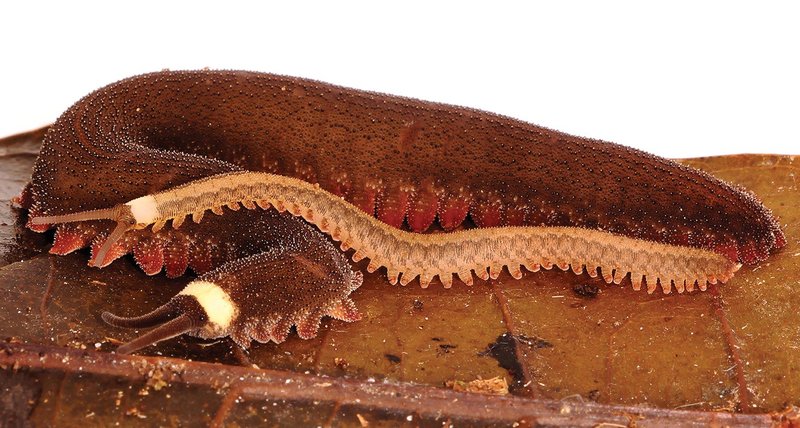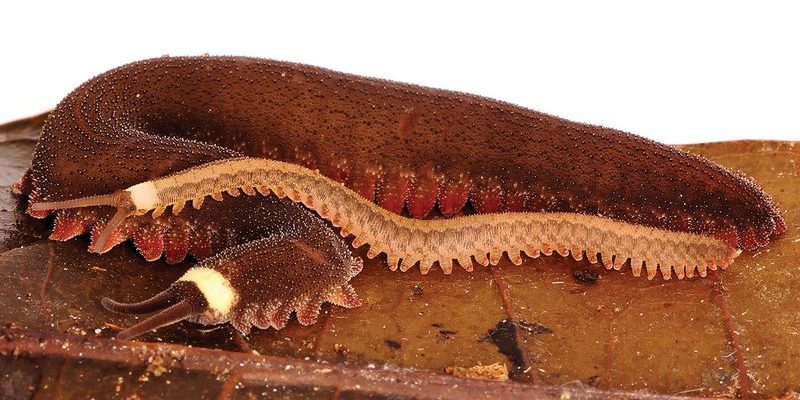
You might be wondering what makes their nervous system so special. Well, here’s the thing: velvet worms boast a nervous system that is quite primitive compared to ours, yet surprisingly effective. It’s like a throwback to an older evolutionary time, offering us clues about how nervous systems have evolved. So, grab your coffee, sit back, and let’s explore the world of velvet worms and their intricate nervous systems!
What Are Velvet Worms?
Velvet worms, or *Onychophora*, are soft-bodied, worm-like creatures primarily found in tropical rainforests. They aren’t actually worms, though; they belong to a family of organisms that share traits with both arthropods and annelids. Picture them as tiny, fleshy caterpillars, measuring anywhere from 1 to 15 centimeters long, and often adorned with tiny, fuzzy tufts that give them a velvet-like appearance.
One of the most intriguing aspects of velvet worms is their lifestyle. They are nocturnal hunters that thrive in humid environments. Using their slime-squirting ability, they can capture prey like insects or small arthropods—think of it as their version of a web, but much stickier! They might not be the fastest predators, but they’ve learned how to adapt to their environment incredibly well.
The Nervous System of Velvet Worms
The nervous system of velvet worms is quite unique and fascinating. Unlike mammals, which have complex, centralized nervous systems, velvet worms possess a more decentralized system that features a brain and a nerve cord. This means they process information differently, relying more on reflexes than on conscious thought.
Imagine your brain as a command center, sending messages out to different parts of your body. In velvet worms, the central nervous system is more like a network of highways that send signals rapidly along their bodies. This setup allows them to respond quickly to predators or prey, keeping them safe and efficient in their hunting endeavors.
Structure of Their Nervous System
The nervous system of velvet worms has two key components: the *supracephalic ganglion* and the *ventral nerve cord*. The supracephalic ganglion acts like a simple brain, helping the worm take in sensory information from its environment. Then, there’s the ventral nerve cord, which runs along the belly of the worm and branches out into smaller nerves that extend to their limbs.
This organization is what gives velvet worms their remarkable abilities. Although they don’t have complex thoughts like we do, they can still navigate their surroundings and respond to stimuli effectively. It’s a great example of how different life forms have tailored their nervous systems for survival.
How Their Nervous System Affects Behavior
You might be curious about how all this affects the behavior of velvet worms. A well-developed nervous system allows them to be incredibly adept hunters. When they sense nearby prey, their nerve signals coordinate quick movements, enabling them to shoot out their slime to trap unsuspecting insects.
This is a fascinating adaptation that highlights how their unique anatomical structure helps them thrive in the wild. The tar-like slime they produce isn’t just for show; it’s a key survival tool. By shooting it out, they immobilize their dinner almost instantly.
Reflex Actions in Velvet Worms
Another interesting feature of velvet worms is their reliance on reflex actions. When threatened, they can curl up or retreat into a burrow rapidly. These quick reflexes are governed by their nerve cords, allowing them to respond without having to process the situation through a complex brain.
For example, if a predator approaches, a velvet worm’s nerve cord can trigger a retreat action almost instantly, giving them a chance to escape before the brain even registers the danger. It’s a fascinating survival mechanism that showcases the beauty of simplicity in the natural world.
Comparing Velvet Worms to Other Invertebrates
If you’ve ever thought about how velvet worms stack up against other invertebrates, you’re not alone. Many people find it intriguing to compare their nervous system to that of insects or octopuses. While insects have more complex, centralized nervous systems, velvet worms’ simpler systems bring them some unique advantages.
For instance, octopuses have a highly advanced nervous system, with a significant portion of their neurons located in their tentacles. This allows them to perform complex tasks and solve problems. Velvet worms, however, focus on straightforward reflexes rather than complex behaviors, which works perfectly for their predatory style.
Understanding these differences helps us appreciate the diverse strategies organisms use to adapt and survive. It’s like a lesson in evolutionary design—each creature is a work of art, sculpted by nature to thrive in its own niche.
The Evolutionary Significance of Velvet Worms
So, why should we care about velvet worms and their nervous systems? Well, they provide a snapshot of early evolutionary history, showing us what simpler life forms looked like millions of years ago. Studying them helps scientists understand how more complex systems evolved over time.
Velvet worms are often considered “living fossils,” meaning they’ve changed very little over millions of years. This makes them an essential subject for researchers interested in evolutionary biology and the development of nervous systems across species. They can help us uncover the secrets of our own nervous systems and how they came to be.
Conservation and Future Studies
With the pressing issues of habitat loss and climate change, many velvet worm species face threats to their survival. Protecting their natural habitats is crucial not just for their sake but also for what they can teach us about evolution. Future studies on their unique nervous systems can shed light on broader biological processes and even inspire technological innovations.
It’s vital to support conservation efforts that aim to preserve these remarkable creatures and their ecosystems. We never know how they might contribute to our understanding of life itself.
Velvet worms might seem like unusual creatures at first glance, but they offer a unique window into the evolution of nervous systems and life on Earth. Their simple yet effective nervous system allows them to thrive as predators in their habitats, showcasing the beauty and adaptability of nature.
As we continue to explore the world around us, let’s not overlook the small marvels, like velvet worms, that teach us about our past and inform our future. By taking an interest in these creatures, we not only deepen our understanding of biology but also foster a greater appreciation for the diversity of life that surrounds us. So, the next time you hear about velvet worms, remember their intriguing characteristics and the role they play in our ecosystem!

